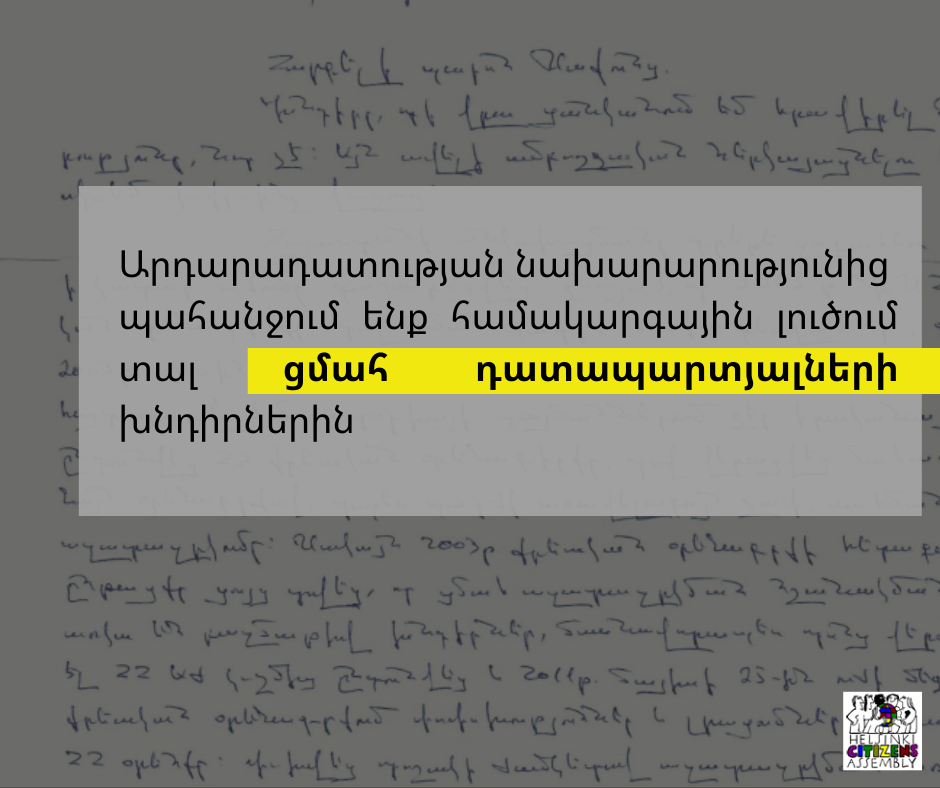On 23 September 2021, the Administrative Court, presided by judge Robert Makeyan, recognized invalid the decision of the Placement Commission of the Central Body of the Penitentiary Service on transferring life-sentenced convict A. Saribekyan from semi-open regime to a stricter one.
The convict had been in the semi-open regime since May 2020, however later, on 25 November 2020, based on Prosecutor A. Khachatryan’s conclusion, the Commission decided to change the regime. Moreover, neither the Commission’s, nor the Prosecutor’s decisions contain proper grounds for that. What is even more, the convict did not even have an opportunity to participate in the administrative proceedings concerning himself and express his opinion.
HCA Vanadzor advocates Hayk Hakobyan and Ani Chatinyan undertook protection of the convict’s rights. First, the advocates appealed the Commission’s decision to the Penitentiary Service, and not reaching any results, they proceeded to appeal it in court.
Though the Prosecutor did not underpin his conclusion and the Commission considered that there was a negative shift in the convict’s conduct, the Court did not think so.
Judge R. Makeyan studied materials of the administrative proceedings and found out that there was no ground for replacing the regime with a stricter one, moreover, “there has been a positive shift in convict Aharon Saribekyan’s conduct”. It was also possible to make a different decision based on the Prosecutor’s decision, yet the Commission preferred to make an unfavorable one.
Thus, the Court upheld the claim, recognized as illegal and invalid the decision of the Placement Commission of the Central Body of the Penitentiary Service.
This attitude to life-sentenced convicts is, however, widespread, and this judgment does not change the situation. A few days ago, a hunger strike was announced by a group of convicts for the same issue; this news was published by human rights activist Zhanna Aleksanyan, HCA Vanadzor was also contacted regarding this issue.
HCA Vanadzor has also been engaged in life-sentenced convict Artur Kocharyan’s case for years on end. HCA Vanadzor has, for many times, raised illegalities in his case and called on law enforcement bodies to deal with this, as well as other life-sentenced convicts’ cases and review them. However, no change has been recorded.
Another life-sentenced convict who applied to HCA Vanadzor is Artak Tchagharyan. A. Tchagharyan raised other systemic issues of life imprisonment. In his letter, he mentions that though recent legislative changes led to fewer life imprisonment cases, rights of those sentenced to life imprisonment earlier still remain neglected.
The thing is that when death penalty was prohibited, persons who were sentenced to death penalty before that (after Armenia’s independence, death penalty was imposed but not applied, as a rule) automatically got the status of life imprisonment; and later, when changes were made in penalties (in 2011, amendments were made to the Criminal Code, according to which, the maximum term of imprisonment was established 20 years instead of previous 15 years), no reference was made to those sentenced to life imprisonment earlier. Actually, persons in the same status, who were sentenced later, have opportunities to get lenient penalties as compared to those sentenced before 2011.
Whereas, the RA Criminal Code clearly establishes that if the legislative change mitigates the punishment, it shall have a retroactive effect and extend to the persons sentenced before the change had taken effect. Nonetheless, it can be seen that this is not applied and rights of life-imprisoned persons continue to be violated and the state does not make any efforts to restore their rights. The issue existed previously and persists after the Velvet revolution.
In this context, the European Court of Human Rights mentions that if the domestic legislation does not have a mechanism of reviewing the punishment imposed or releasing the imprisoned person earlier, or if there is such a mechanism but the relevant person cannot use it, there is the right to be free from torture established by Article 3 of the European Convention on Human Rights.
In another case, the ECHR recorded that there should be a maximum, justifiable and adequate limit of imprisonment, after which the offender should be given an opportunity to show that he/she deserves to return to society.
Back in 1976, the CoE Committee of Ministers reviewed issues concerning long-term imprisonment and parole and adopted a resolution, which records that no person shall be deprived of the opportunity to restore their freedom. The Committee suggested applying the same principles to life-imprisoned persons as they are applied in case of persons convicted to long-term imprisonment, as well as to regularly review the sentences of persons convicted to life imprisonment. In another recommendation, the Committee mentioned in 2003 that criteria for parole should be clear, comprehensible and realistic, should take into account a person’s characteristics, social and economic conditions, as well as possibilities of social rehabilitation programs. And it is up to the authorities to prove non-compliance with these criteria.
In its “Actual/whole life sentence” report, the Committee for Prevention of Torture presented serious observations in terms of considering life-imprisoned persons a constant threat to society. The Committee mentioned that no refusal to restore freedom should be final, even if that person has returned to prison for breaching conditions of parole.
Taking into account the above-mentioned conditions, we demand from the RA Ministry of Justice to give a legal solution to this issue and restore rights of life-imprisoned convicts.

